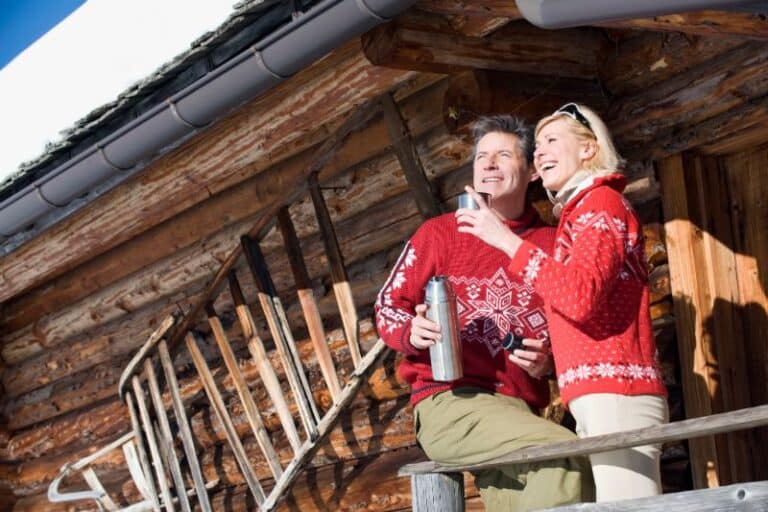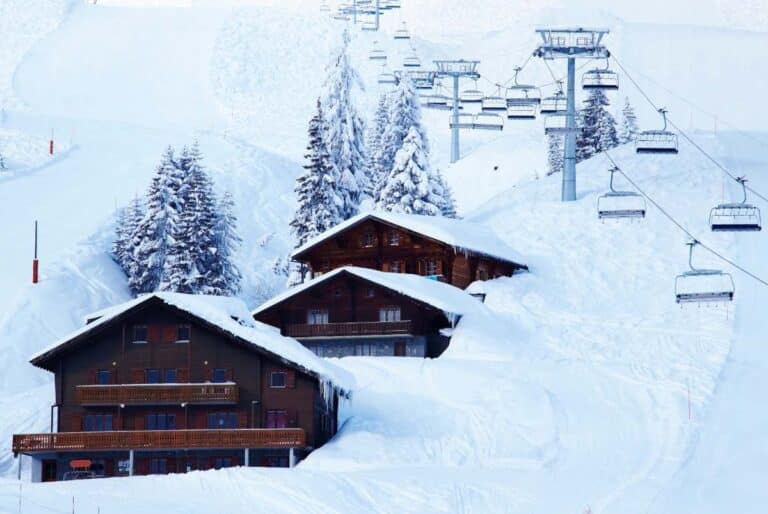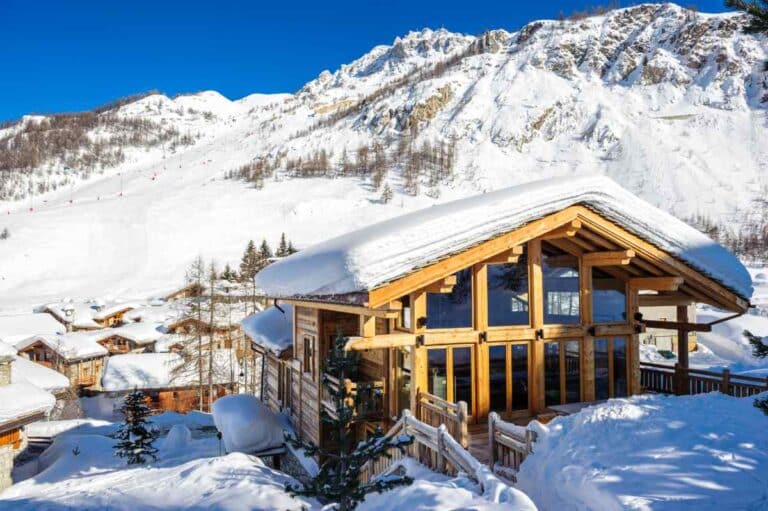As summer starts to fade and the crisp chill of autumn creeps in, many of us begin to dream about snowy mountains, log fires, and fresh powder days on the slopes. If you’re planning a group ski trip this year, now is the perfect time to start thinking about where to stay.
One of the most popular options is the ski chalet holiday – the ultimate cosy base where your whole group can relax together after long days on the mountain. But if you’ve never booked one before, the process can feel a little overwhelming. Where do you find them? What should you look out for? How much to pay and how do you avoid any booking scams?
Don’t worry – this guide has you covered. Here’s everything you need to know about booking your perfect ski chalet.
Why choose a ski chalet holiday?
Unlike hotels, chalets give you that home-from-home feeling with the added benefit of stunning mountain views. You get shared living spaces, roaring log fires, and often the option of ski-in/ski-out locations so you can clip in right at the door.
They’re also brilliant for groups. Whether you’re travelling with family, a bunch of friends, or even on a corporate retreat, a chalet keeps everyone together under one roof. There’s plenty of room for communal dinners, late-night card games, and sharing slope stories over a bottle of wine.
And let’s not forget the food! Chalets often come in two styles – catered or self-catered. With a catered chalet, you’ll have meals prepared for you (sometimes even a private chef), which means more time on the slopes and less faffing in the kitchen. Self-catered chalets, on the other hand, give you more flexibility and often come at a lower price point.
Best platforms to find ski chalets
The first question is usually: where do I actually find these chalets? Luckily, you’ve got options:
Specialist chalet agencies
These companies focus exclusively on ski holidays and usually have vetted, high-quality listings. Examples include Iglu Ski, ChaletFinder, and Ski Solutions.
General booking platforms
Websites like Airbnb and Booking.com list chalets too but always double-check the reviews and details carefully.
Tour operators
Many big ski holiday operators offer package deals that include flights, transfers, and chalets – ideal if you want everything sorted in one go.
Direct bookings
Some chalet owners manage their own websites and take bookings directly. This can sometimes be cheaper and you’ll often receive a more bespoke service however it can but require a bit more extra care to ensure legitimacy.
Criteria to consider when booking

Not all chalets are created equal, so it’s worth thinking about your priorities before booking. Get it right, and your chalet will elevate the whole trip. Get it wrong, and you could end up with long walks in ski boots, cramped bedrooms, or a hefty bill that doesn’t quite feel worth it.
Before you commit, it’s worth weighing up a few key factors to make sure the chalet fits your group’s needs and expectations.
Destination
The resort you choose will shape your entire ski holiday, so think about what matters most to your group:
- Popular resorts: Places like Val d’Isère, St. Anton, and Verbier offer lively après-ski scenes, extensive terrain, and a big choice of chalets – but they can be pricey and crowded in peak weeks.
- Hidden gems: Smaller resorts are often cheaper, quieter, and more authentic, though they may have fewer pistes and amenities.
- Family-friendly: Resorts like La Plagne or Les Gets are known for gentle slopes, good ski schools, and activities for non-skiers.
- Advanced skiing: If you’ve got thrill-seekers in the group, look for destinations with challenging terrain and off-piste opportunities.
- High altitude: Resorts over 1,800m tend to be snow-sure from December through April – handy if you’re booking early or late in the season.
Location
Do you want ski-in/ski-out convenience, where you can clip in at the door, or would you prefer being in the heart of a charming alpine village with shops, cafés, and après-ski bars nearby? Remember, slopeside chalets often come with a higher price tag, while village chalets give you more of a cultural feel (and usually better restaurant options).
Size and layout
Make sure the chalet has enough bedrooms and bathrooms to comfortably fit your group. For larger groups, en-suites and multiple living areas can make a huge difference. If you’re travelling with kids, bunk rooms are often a fun and practical option.
Catering
Decide between self-catered, catered, or half-board. Catered chalets often include breakfast, afternoon tea, and dinner – sometimes with wine thrown in – which takes the pressure off organising meals. Self-catered chalets give you flexibility but remember that alpine supermarkets can be pricey and not always within walking distance.
Amenities
The little luxuries can really enhance your chalet experience. Hot tubs, saunas, fireplaces, ski storage rooms with boot warmers, and even home cinemas can make a week in the mountains extra special.
Budget
Prices vary massively depending on resort, size, and season. Booking early usually gets you the best deals, while last-minute bargains can be risky but rewarding. Don’t forget to factor in lift passes, ski hire, transfers, and catering costs when setting your budget.
Proximity to ski schools/lifts
This is especially important if you’re travelling with beginners or children. A chalet that’s a ten-minute trudge away might not sound bad on paper, but after a long day in ski boots (or with little ones in tow), it can feel like a marathon.
Proximity to airports
It’s easy to get swept away by chalet photos and forget about the journey. Some resorts are just 60–90 minutes from major airports, while others can take 3–4 hours – and that’s before factoring in snowy road conditions. Ask yourself:
- Will you be hiring a car or booking a shared transfer?
- How much time do you want to spend travelling on arrival and departure days?
- Is there reliable public transport if some of the group aren’t hiring a car?
Shorter transfers can make a big difference, particularly if you’re only skiing for a long weekend or travelling with children.
Popular ski chalet destinations
One of the best parts of booking a ski chalet is the sheer variety of destinations you can choose from. Europe is dotted with world-class ski resorts, each with its own unique personality, terrain, and après-ski culture. Whether you’re after glamorous nights out, family-friendly slopes, or off-the-beaten-track villages, there’s a chalet to match.
France, Switzerland, Austria, and Italy are the classic big-hitters – and for good reason. Their resorts combine stunning alpine scenery with excellent infrastructure and a wealth of chalet accommodation to suit all budgets. From bustling mega-resorts with hundreds of kilometres of pistes to tucked-away alpine towns that feel like hidden gems, you’ll find plenty of choice.
Here are a few highlights to get you started:
France: The French Alps are chalet heaven. Try Val d’Isère for luxury, Les Trois Vallées (Courchevel, Méribel, Val Thorens) for vast terrain.
Switzerland: Zermatt and Verbier are known for their picture-postcard views and glamorous après-ski scenes.
Austria: St. Anton is a party hotspot, while Kitzbühel offers charm and tradition as well as a party vibe.
Italy: The Dolomites are a UNESCO World Heritage Site with incredible scenery – Cortina d’Ampezzo is the jewel in the crown. You also have the famous Sellaronda circuit – skiing through all the main Dolomite resorts.
Travel tips for the Alps

Planning your chalet holiday doesn’t stop once you’ve chosen your resort – the journey there and the little details can make a big difference to how smoothly your trip goes. The Alps are well connected, and getting there is usually straightforward, but a bit of forward-thinking can save you time, money, and stress.
A few little planning tips can make it smoother:
Best time to travel
Peak season is over Christmas, New Year, and February half-term. If you want quieter slopes and cheaper prices, aim for January or March.
Transport options
The most common route is flying into Geneva, Zurich, or Milan, then arranging a transfer or hire car. Trains are also a lovely, scenic way to travel. From the UK, it’s also possible and cost effective to drive, taking the ferry or shuttle to France with a stop off along the way.
Packing essentials
Don’t forget chalet-friendly items like slippers (many chalets are shoe-free indoors), plug adaptors, layered clothing, and high-factor sunscreen (yes, you can burn on snowy days).
Ski passes & equipment
Booking in advance often saves money and avoids long queues when you arrive.
Cost and criteria of travelling with ski equipment, especially on flights.
Precautions when booking
While the majority of ski chalet bookings are perfectly safe and legitimate, the unfortunate reality is that scams do exist – and when they do, they can be expensive and stressful. The good news is that they’re relatively rare, and with a bit of common sense and due diligence, you can easily avoid them.
It’s also worth noting that many travel insurance policies won’t cover losses related to fraud or scams, unless you’ve booked through secure methods. That means prevention really is better than cure. Doing your homework before you book can save you a lot of hassle (and money) later.
This checklist gives you some tips:
Beware of fake listings: If the price looks too good to be true, it probably is. Always book through reputable platforms or operators.
Avoid bank transfers: If you’re asked to transfer money directly to a private bank account, consider it a red flag. Use secure payment methods.
Check reviews & ownership: Google the chalet name, check independent reviews, and confirm contact details.
Importance of ski holiday insurance

Even if you’ve booked safely, skiing is an activity with more risks than your average beach holiday – which is why ski travel insurance is essential. Standard travel insurance often doesn’t cover skiing, so make sure you opt for a policy that specifically includes it.
What winter sports insurance usually covers
- Winter sports activities: Skiing, snowboarding, and often extras like snowshoeing or tobogganing (always check the small print).
- Medical emergencies: Including on-piste accidents, mountain rescue, and hospital bills.
- Cancellations and delays: Helpful if you fall ill before your trip or if your travel is disrupted.
- Equipment: Lost, stolen, or damaged skis, boots, and boards.
- Personal liability: Cover in case you accidentally injure another skier or damage property.
What it might not cover
- Off-piste skiing solo: Many policies exclude this unless you’re accompanied by another person or a qualified professional.
- Heli-skiing: This often requires additional cover.
- Alcohol-related incidents: Claims may be denied if the insurer deems alcohol played a role in an accident.
*Different policies will have different specific criteria so always check policy documents to ensure the policy you choose covers everything you need.
Final thoughts
Booking a ski chalet might feel daunting at first, but once you’ve found the right one, it’s hard to beat the experience. From cosy evenings by the fire to the thrill of stepping out onto the slopes each morning, a chalet holiday offers the perfect mix of comfort, convenience, and mountain magic.
So, start browsing now, check those reviews, and before long you’ll be clinking glasses of fizz or vin chaud with your group in your very own alpine retreat.
Secure Ski Insurance from SportsCover Direct
Ski insurance can provide all the usual travel cover you’d expect, while also offering specialist protection for winter sports, helping you avoid costly setbacks if things don’t go as planned.
SportCover Direct has a ski insurance policy that can be tailored to several different ski disciplines – select the activities you need when you get a quote.
Our policy includes cover for medical emergencies, cancellations, personal liability, lost or damaged equipment, search and rescue operations, and even off-piste skiing, provided you follow local advice.
Find out more about our specialist ski policies online.
This blog has been created as general information and should not be taken as advice. Make sure you have the correct level of insurance for your requirements and always review policy documentation.